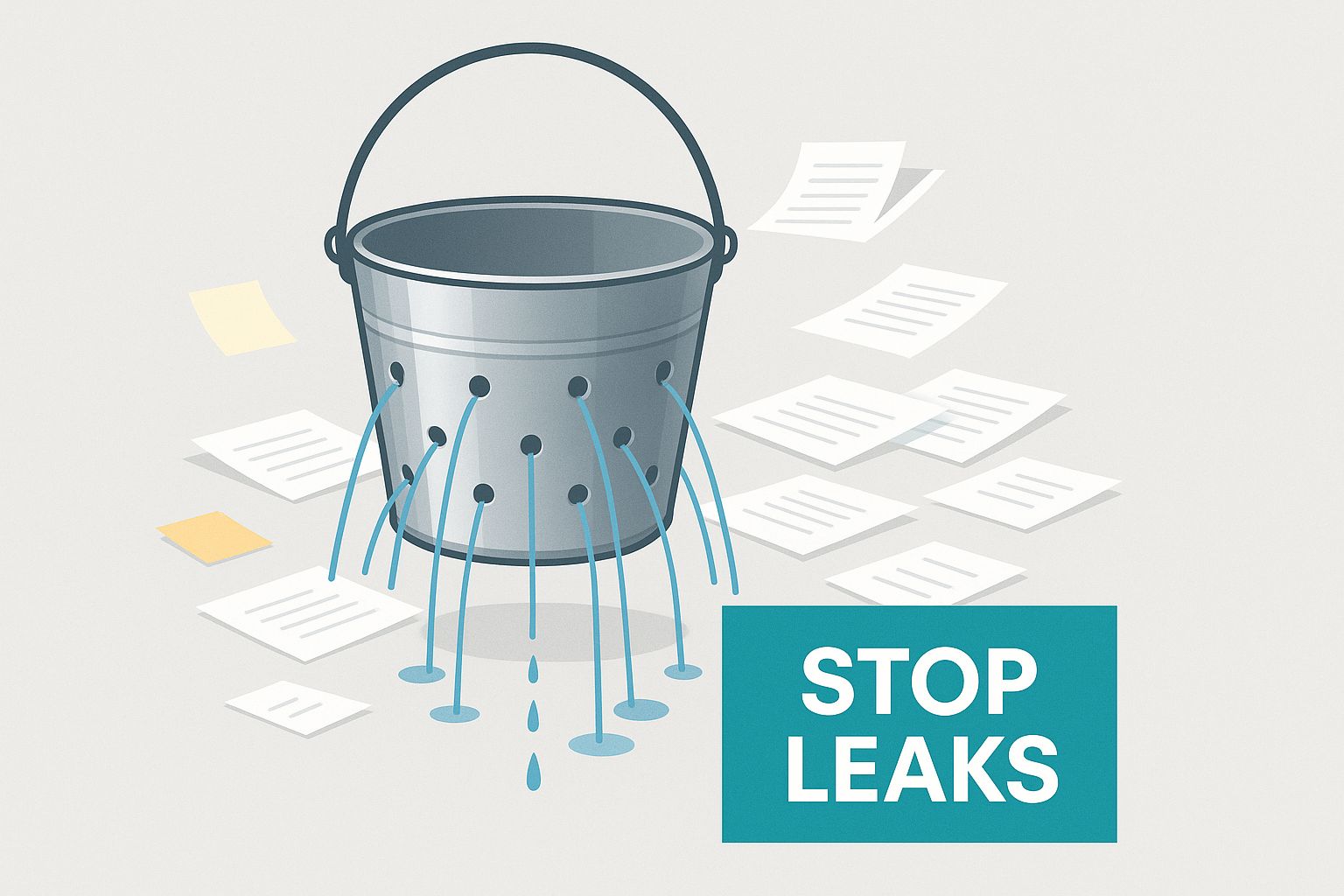Mastering Lead Management Software for Growth
Stop letting valuable leads slip away. This guide demystifies lead management software, showing you how to capture, nurture, and convert like a pro.

Sorry, but generating leads is hard work. But what’s truly frustrating is watching those hard-won prospects go cold because your follow-up is a chaotic mess of spreadsheets, forgotten reminders, and sticky notes. I’ve been there—juggling contacts, losing track of conversations, and feeling that constant, gut-wrenching anxiety of missed opportunities. This isn't just a small drip; it's a massive hole in your revenue bucket, and it's exhausting.
Why Your Sales Process Feels Like a Leaky Bucket
The core problem with manual systems is that they're built on a foundation of hope and memory, neither of which scales. As your business grows, so does the complexity. That spreadsheet that worked for your first ten leads becomes an unmanageable beast by the time you hit one hundred. You start losing the thread of conversations, and opportunities inevitably slip through the cracks.
This chaos directly impacts your bottom line. Every lead that goes cold because of a missed follow-up is a tangible loss of potential revenue. It’s the reason so many businesses feel like they're constantly pouring water into a leaky bucket—the effort is there, but the results just don't hold up.
From Chaos to Clarity
The truth is, a messy process guarantees you'll leave money on the table. Important details get lost, sales cycles drag on, and your team spends more time trying to stay organised than actually selling. You end up reacting to problems instead of proactively building relationships with your best prospects.
The infographic below visualises this common problem, showing how scattered data and manual tracking lead to significant leaks in the sales process.

This illustration perfectly captures that feeling of inefficiency—countless efforts resulting in lost potential. To plug these holes, you need a centralised system that moves you from chaotic tracking to a streamlined workflow, ensuring every lead is nurtured effectively. This is where dedicated lead management software becomes essential.
For a deeper understanding of how this structure fits into the broader picture, you can learn more about building a B2B sales funnel. This shift allows you to finally stop patching leaks and start building a solid foundation for growth.
What Is Lead Management Software Really?
Let’s cut through the jargon. At its heart, lead management software is your business's central hub for every potential customer. Picture it as an air traffic control system for your sales pipeline; it takes every lead that comes in and carefully guides it from initial contact right through to becoming a satisfied customer.

This is so much more than a glorified digital address book. It's a smart system built to automatically grab leads from all your channels—your website, social media, emails, you name it—and then organises all their information. Most importantly, it tells your team exactly who to talk to next, and why.
This kind of systematic approach is no longer a "nice-to-have". As businesses everywhere look for smarter ways to work, the demand for specialised tools is growing. The global software market is on a trajectory of significant expansion, which just goes to show how critical these platforms have become for businesses aiming to stay competitive. You can read more about software market growth projections to see the trend for yourself.
Breaking Down The Core Functions
At their core, most lead management platforms are built around a handful of key functions. These features work together to transform the messy, often chaotic process of handling new enquiries into something predictable and organised. Once you understand these, you'll see exactly how the software stops potential customers from slipping through the cracks.
Here's a simple breakdown of what these essential features do and why they're so important for your business's growth.
Core Functions of Lead Management Software
| Function | What It Does | Why It Matters |
|---|---|---|
| Lead Capture | Automatically pulls in leads from sources like website forms, emails, and social media. | It gets rid of manual data entry, cutting down on errors and making sure no lead gets lost, no matter how they found you. |
| Lead Tracking | Creates a detailed timeline of every interaction a lead has with your business. | Your sales team gets the full story on a lead's journey, which means every follow-up call or email is relevant and personal. |
| Lead Scoring | Ranks leads based on their profile and actions to show you who is most interested. | It helps your team focus their energy on the hottest prospects—the ones most likely to actually buy something. |
| Lead Nurturing | Automates follow-up communications, like emails or reminders, based on a lead's behaviour. | This keeps your brand at the front of their mind and gently guides them along the sales process without your team having to do it all manually. |
These functions are the engine of any good lead management system, turning raw interest into real opportunities.
Why Data Quality Is The Real Secret
Here's something a lot of people miss: your lead management software is only ever as good as the data you put into it. A name and an email address from a simple PDF download form doesn't tell you much about what that person actually needs or how serious they are.
This is where you can get a serious competitive edge.
Interactive content like quizzes, assessments, and calculators doesn’t just capture a lead; it captures a rich profile of their challenges, goals, and buying signals. This deeper data makes your entire management process more efficient from day one.
When your system is fuelled by leads who have already told you what they're struggling with, your lead scoring becomes laser-focused. Your automated emails can be personalised to their specific problems, not just generic marketing messages. Suddenly, your software isn't just a tool for staying organised—it's a powerful engine driving real growth.
Fuelling Your System with Data-Rich Leads
Let's be honest for a moment: not all leads are created equal. And here’s a take that might stir the pot a bit—most lead magnets are just plain boring. A generic PDF download gives you exactly one piece of information: an email address. That's a terrible way to start a relationship and an even worse way to fuel your expensive lead management software.

Your software absolutely thrives on data. The more it knows about a prospect, the better it can help you score, segment, and nurture them toward a sale. Feeding it a long list of anonymous emails is like putting low-grade fuel in a high-performance engine. Sure, it’ll run, but it's going to sputter and perform poorly. You'll spend all your time guessing what your leads want instead of actually knowing.
Moving Beyond Basic Email Collection
This is where things get really interesting. I've seen firsthand how interactive content like quizzes, assessments, and calculators completely changes the game. Instead of just one data point, you get a rich profile detailing a prospect's real needs, challenges, and goals. And the best part? They provide this information willingly, in exchange for getting some instant, personalised value.
Let's just compare two scenarios:
- Lead A: Downloads a PDF called "10 Marketing Tips for 2024." You have their email. That’s it.
- Lead B: Completes a 5-question "Marketing Maturity Assessment." Now you know their email, their company size, their biggest marketing challenge, their current budget range, and their main growth goal for the next quarter.
Which lead is more valuable? It’s not even a contest. Lead B is already pre-qualified and pre-segmented. This is the kind of high-octane data your lead management software was designed to run on.
Feeding your software leads who have already articulated their pain points and goals is the single biggest lever you can pull for sales efficiency. Your follow-up becomes instantly relevant, your sales team operates with surgical precision, and your conversion rates climb.
The Power of Interactive Qualification
When your system is fed with leads from an interactive funnel, your whole process gets smarter. Lead scoring is no longer based on vague assumptions; it's based on explicit answers. Automated nurturing sequences can be tailored to the exact problem a person told you they have.
This approach turns your software from a simple organisational tool into a genuine strategic powerhouse. If you're struggling to make this shift, it's worth taking a step back to understand how to build a modern lead generation system from the ground up.
If your lead magnets feel a bit stale and aren't delivering the deep insights you need, it might be time for an audit. Tools like the free lead magnet audit from Magnethive can analyse your current approach and provide AI-powered ideas for interactive content, showing you exactly how to start gathering data that truly matters.
How to Choose the Right Software for Your Business
The market for lead management software is absolutely flooded. Every provider claims their tool is the magic bullet, and it's incredibly easy to get stuck in analysis paralysis. Worse, you could pick a tool that ends up being a glorified, expensive spreadsheet that nobody on your team actually uses.
To cut through the noise, you need a practical framework. Let's set aside the endless feature-comparison charts for a minute and focus on what your business truly needs to grow. You're looking for a partner in your sales process, not just another line item on your monthly credit card bill.
The push for better customer engagement has caused an explosion in these tools. Businesses everywhere are scrambling to get their sales process in order, and the right software is a massive piece of that puzzle. In fact, you can read more about the lead management market's growth to see just how critical these systems have become globally.
100% Free Lead Magnet Audit
Our AI analyzes your website and delivers custom growth strategies in seconds.
Ask These Questions Before You Buy
Before you even think about booking a demo, pull your team together and get honest answers to these questions. This initial clarity will be your North Star through the whole selection process.
- What's our biggest headache right now? Are leads slipping through the cracks because follow-up is too slow? Is our lead data a complete mess, spread across a dozen different places? Do we have no idea which leads are hot and which are cold? Pinpoint the single biggest problem you expect this software to fix.
- Who is actually going to use this every day? I can't stress this enough: a clunky, confusing interface is a deal-breaker. If your sales reps find the software a chore to use, they simply won't. I'd take a clean, simple UI over a tool with a million features buried in confusing menus any day of the week.
- How does it play with our other tools? Your lead management software can't operate in a vacuum. Does it integrate smoothly with your email marketing platform, your website, and other essential apps? A system that doesn’t connect just creates more soul-destroying manual work for your team.
- What's our real, all-in budget? Look past the shiny monthly price tag. Are there hidden fees for setup, training, or extra contacts? Get a clear picture of the total cost of ownership before you commit.
Choosing software isn't about finding the "best" platform on the market. It's about finding the right platform for your team's unique workflow and where you are as a business. A simple tool that people love to use is infinitely more valuable than a powerful one that gathers digital dust.
Getting clear on these points helps you build a tight shortlist of real contenders. It also ensures you’re building a connected system that works together, not just a collection of separate tools. To see how this fits into the bigger picture of your customer's journey, take a look at our guide on selecting a marketing funnel builder.
Implementing Your System for Lasting Success
So, you've picked out your new lead management software. That's actually the easy part. The real work, and where I’ve seen so many businesses fall flat, is getting the team to buy in and actually use it every day. A shiny new tool nobody touches is just an expensive icon on your desktop.
Successful implementation isn't like flipping a switch. It’s about a smart, gradual rollout. Don't try to unleash every single bell and whistle on day one. You’ll just overwhelm everyone.
The secret is to start small and build from there. Your initial goal is simple: get your team comfortable with the absolute basics. Think lead capture and tracking interactions. Once that becomes second nature, you can start layering in the more advanced features.
Defining Your Rules of Engagement
Before you even think about moving your data over, you need to get everyone in a room and agree on some ground rules. What exactly is a "lead" in your organisation? Even more crucial, what are the crystal-clear definitions for each stage of its journey?
- Marketing Qualified Lead (MQL): What specific action tips a prospect over into this category? Is it downloading a whitepaper? Attending a webinar? Define the exact trigger so there’s zero guesswork.
- Sales Qualified Lead (SQL): At what precise moment is a lead considered ready for a sales call? This handover is where the friction usually happens, so getting marketing and sales to agree on this is non-negotiable.
Getting this clarity upfront saves you from a world of headaches and blame games down the line. Without these shared definitions, your new system is just a digital filing cabinet for arguments. These rules become the bedrock of your lead scoring and ensure the entire team is on the same page.
The aim isn't to create a flawless, all-encompassing system overnight. It's to build a straightforward system that your team actually understands and trusts from the get-go. Simplicity is what gets people on board, and that adoption is what produces results.
Beyond Static Data Dumps
As you prepare to import your existing contacts, think about the quality of that data. A simple list of names and email addresses doesn't give your sales team much to work with, does it? This is exactly why leads that come from interactive content, like quizzes or ROI calculators, are absolute gold.
Imagine importing a new lead who has already told you their biggest pain points, their budget range, and their ideal project timeline. You’re not just giving your sales team a contact; you’re giving them a conversation starter on a silver platter.
Suddenly, the software is more than just a database—it's a tool for sparking genuinely relevant discussions. The whole process becomes so much more powerful when you start with richer data, and interactive content is the fastest way to get it. This kind of context makes every other feature, from automated scoring to email nurturing, work ten times better.
Taking Your Lead Nurturing to the Next Level
So, you've got your lead management software up and running. That's a great first step, but now it's time to really put it to work. Let's move past the out-of-the-box settings and explore the strategies that transform your system from a simple database into a serious revenue-generating machine.
A brilliant place to start is by rethinking how you score your leads. Too many businesses fall into the trap of only looking at demographic data—things like company size, industry, or a person's job title. That’s missing the bigger picture. The real magic happens when you start factoring in behavioural data.
Think about it: who's a hotter lead? The CEO who downloaded a high-level whitepaper once, or the marketing manager who's visited your pricing page three times, watched a full product demo, and checked out a case study? It's clearly the manager. Your scoring model needs to reflect that kind of engagement.
Ditching Static Follow-Ups for Dynamic Journeys
This is also where interactive content can completely change the game. Forget sending the same old "thanks for your download" email to every single person. Instead, you can use the data you gather from something like a quiz or an assessment to create truly dynamic and automated follow-up sequences.
Here’s what that looks like in the real world:
- A potential customer takes your "Marketing Automation Maturity Quiz."
- Their answers tell you their single biggest pain point is "poor lead data quality."
- This insight instantly triggers a tailored email sequence. First, they get a case study on data cleansing. A few days later, an invitation to a webinar on that exact topic lands in their inbox.
See the difference? This isn't just generic marketing; it's providing a specific solution to a known problem, right when they're thinking about it. The software automates the delivery, but the strategy is driven by the rich data you collected. This is the kind of powerful insight you get from tools like quiz funnels, making your entire lead management process smarter and far more effective.
The ultimate aim is to make every touchpoint feel like a one-on-one conversation. When someone feels like you truly understand their challenges, they stop seeing you as just another vendor and start seeing you as a trusted advisor. That’s when they’re ready to talk to sales.
The explosive growth in related tools shows just how vital these digital solutions have become. The lead capture software market, for example, is forecast to hit $5.69 billion by 2035, which highlights the massive industry-wide push to perfect customer engagement. Discover more insights about this market expansion.
Of course, to fuel these advanced strategies, you need a consistent flow of high-quality leads packed with useful data. If you’re not sure whether your current lead magnets are up to the task, running them through the **free lead magnet audit from Magnethive at https://magnethive.io**?ref=post could be a real eye-opener. It generates a comprehensive report with 3 AI-powered lead magnet ideas, analysis of your current lead magnet, and shows ROI impact.
Answering Your Burning Questions
You've got questions, and that's a good thing. It shows you're taking this seriously and want to find the right tool for the job. Let's dig into a few of the most common questions I hear when people are looking into lead management software.
What’s the Real Difference Between Lead Management and a CRM?
It’s easy to get these two mixed up. Think of it like this: lead management is a specialist, while a CRM is a general practitioner.
Lead management software is laser-focused on one critical part of the journey: turning a curious stranger into a sales-ready lead. Its entire purpose is to capture, track, qualify, and nurture those potential customers before they ever speak to a salesperson.
A Customer Relationship Management (CRM) system, on the other hand, has a much wider scope. It’s designed to manage the entire customer relationship, from the very first interaction all the way through to long-term loyalty and support. While most CRMs have lead management features built-in, a dedicated system often gives you more powerful, specialised tools for that crucial pre-sale phase.
How Much Should I Actually Budget for This?
This is the big one, isn't it? The price range is massive, swinging from free, limited plans to high-end enterprise systems that can run into the thousands each month. For a small business, you can typically find a solid starting point for under $100 per month.
But here's my honest advice: stop focusing only on the sticker price. The real cost is paying for software your team hates and refuses to use. A simple, affordable tool that everyone on your team actually uses is worth ten times more than a feature-packed, expensive platform that just gathers dust.
When Is It the Right Time to Get Software?
Here's a take that might surprise you: you probably needed it yesterday.
If you're currently trying to manage leads in a spreadsheet and you can feel that slight sense of panic when you realise you missed a follow-up or can't find an important note, you've already hit the limit of your manual process. That's the first sign of a leaky bucket.
Getting a proper system in place early on does more than just stop the leaks; it builds good habits. It creates a solid foundation that can grow with you. Trust me, it’s far less painful to start organised than it is to try and sort out a massive, chaotic mess down the line.